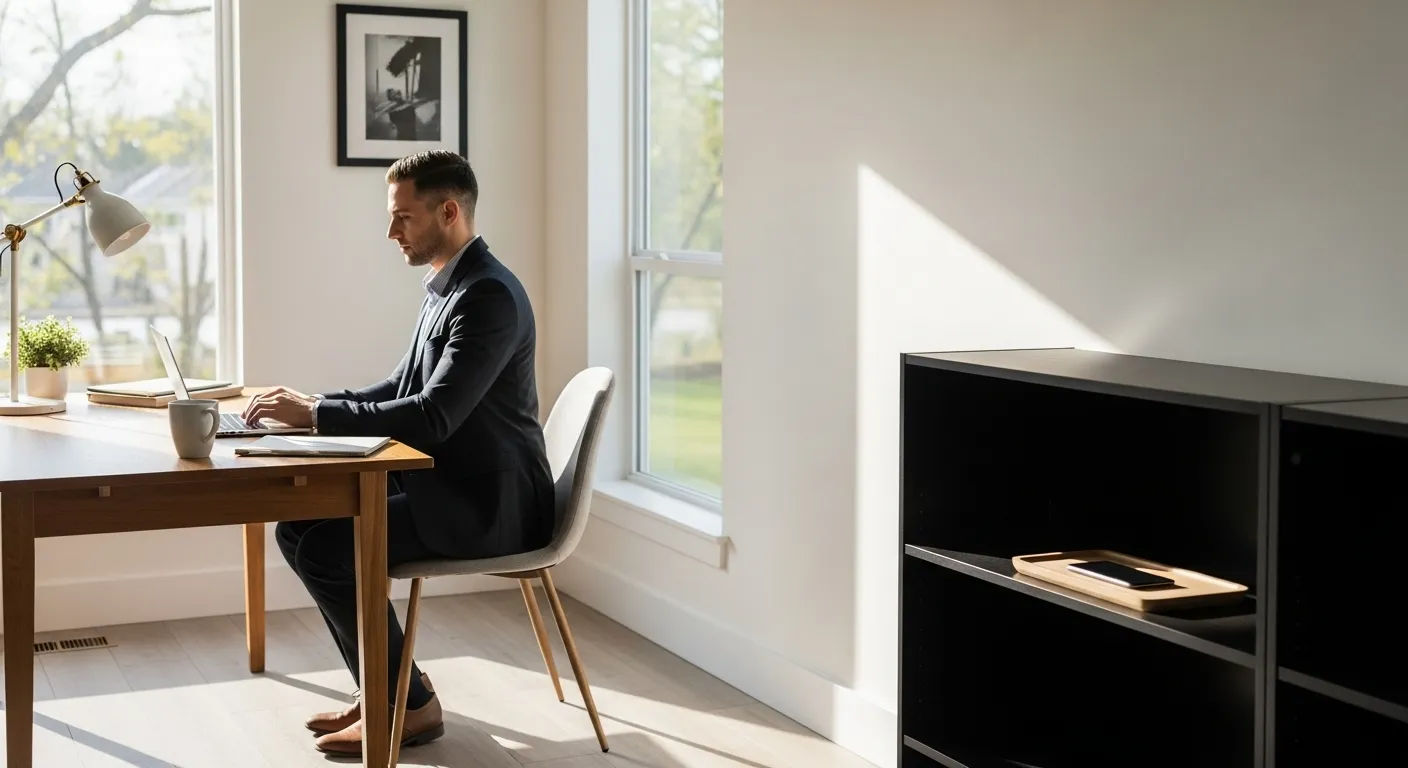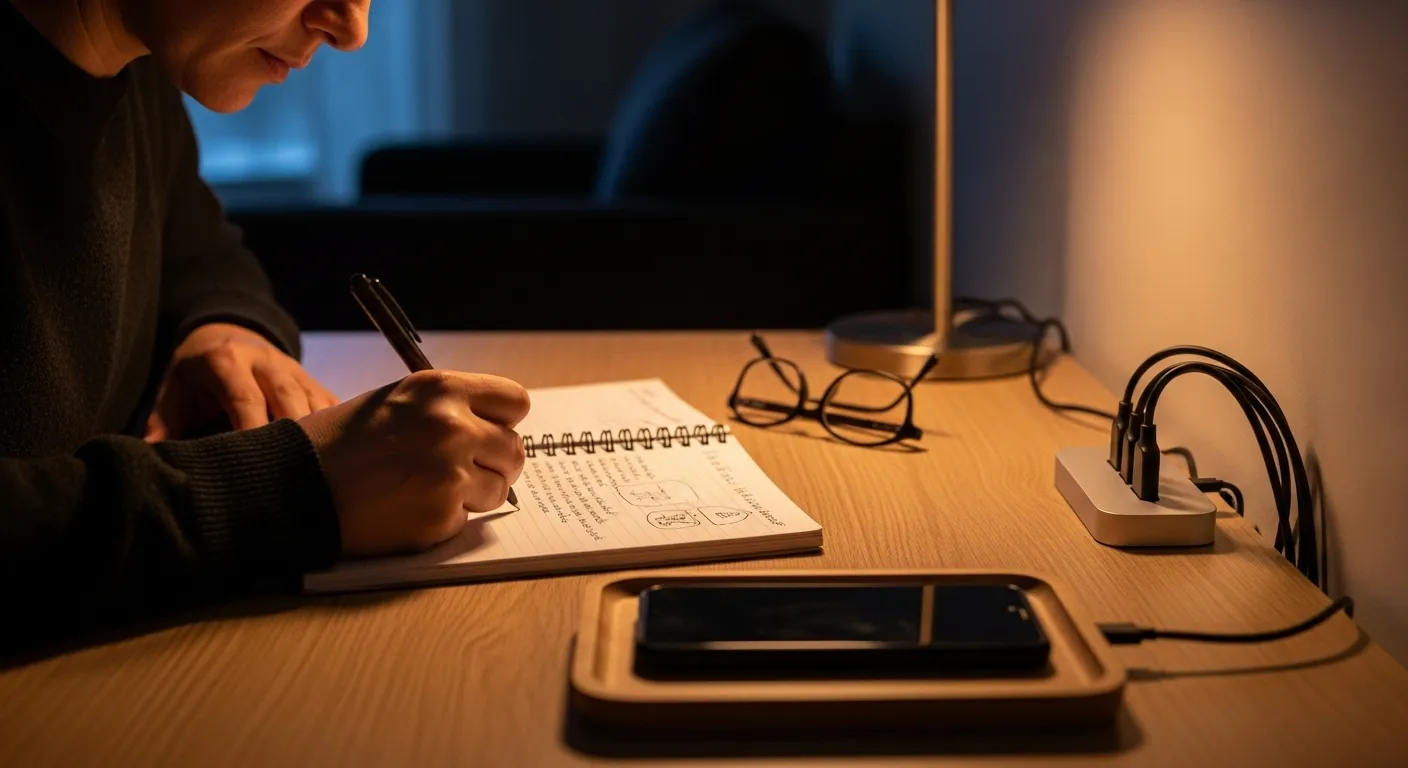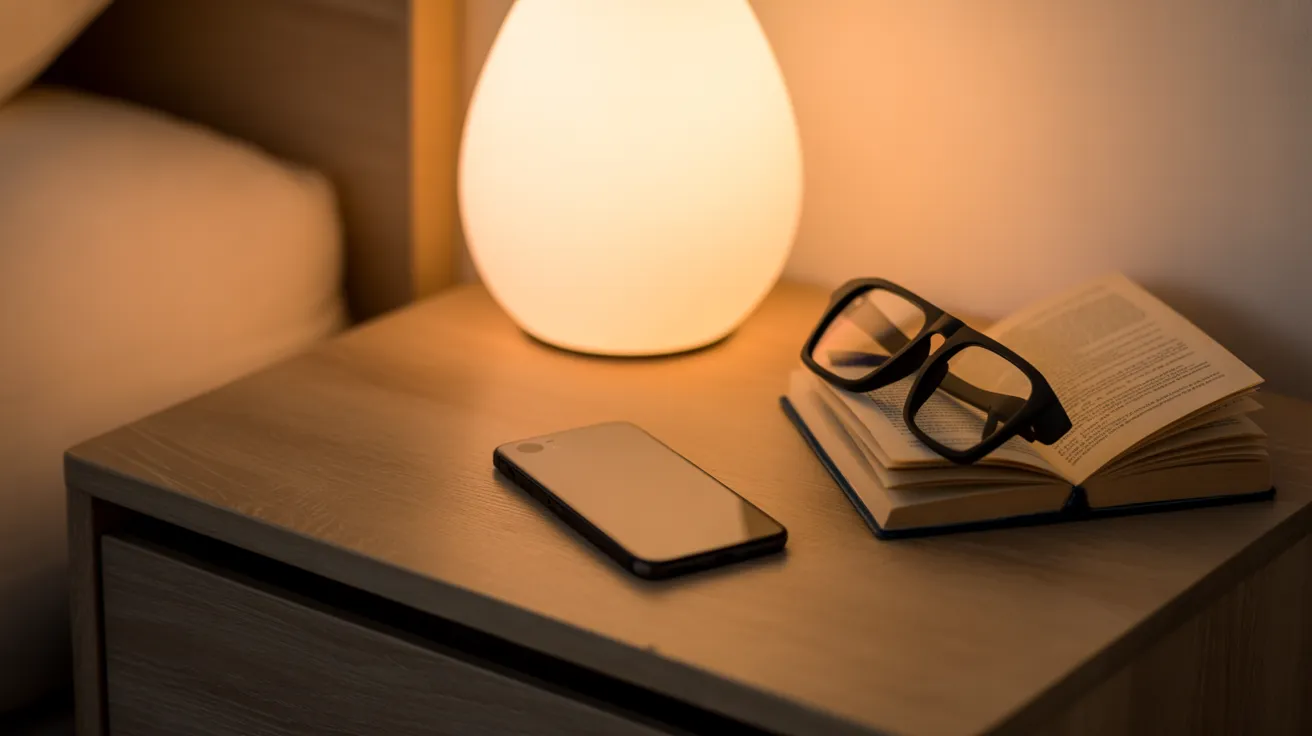
📚 Table of Contents
- Understanding the Attention Economy: Why Your Phone Is So Distracting
- Building Your Focus-First Phone: Practical Routines and Setups
- Step 1: The Great App Declutter
- Step 2: Designing a Minimalist Phone Home Screen
- Step 3: Mastering Your Notifications with Batching
- Step 4: Using App Timers and Focus Modes
- Your Environment Matters: Creating Digital Boundaries in Your Physical World
- Establishing Screen-Free Zones in Your Home
- The Sleep-Friendly Evening: Winding Down Without Screens
- Creating Cues for Deep Work
- Putting It Into Practice: Two Worked Examples
- Troubleshooting Common Challenges: Staying the Course
- Handling Relapse and Resisting the Urge to Re-Clutter
- Navigating FOMO (Fear of Missing Out)
- Managing Social and Professional Expectations
- Frequently Asked Questions About a Minimalist Phone Setup
- Q: How does a minimalist phone setup affect my privacy?
- Q: I work night shifts. How can I adapt these tips for my schedule?
- Q: Can these principles be applied to a phone I share with my kids or for parental controls?
- Q: My job requires me to be constantly available. How can I declutter my phone without compromising my work?
- Your First Steps to a More Focused Life
How many times have you picked up your phone to check one simple thing—the weather, a message, the time—only to look up 45 minutes later, lost in a sea of notifications, headlines, and endless scrolling? If you feel a familiar pang of recognition, you are not alone. Our days are often fragmented into a thousand tiny digital pieces, leaving us feeling scattered, unproductive, and strangely exhausted.
The constant buzz in our pocket promises connection and information, but it often delivers distraction and anxiety. The cost is high. We lose precious hours of deep work, disconnect from the people in front of us, and sacrifice the quiet moments that allow our minds to rest and generate new ideas. The feeling of being “always on” is a fast track to burnout.
But what if the solution isn’t to throw your phone into the sea? For most of us, living in a connected world means technology is a non-negotiable part of our lives for work, family, and logistics. The answer isn’t digital amputation; it’s digital architecture. It’s about transforming your phone from a relentless slot machine for your attention into a streamlined, intentional tool that serves you, not the other way around.
This guide is your blueprint for a comprehensive phone declutter. We will walk you through the psychology of why your device is so hard to put down and provide a step-by-step process to create a minimalist phone setup. This isn’t about extreme measures or unrealistic rules. It’s about designing a digital environment that fosters focus, enhances productivity, and ultimately gives you back your time and attention. Let’s begin the journey to a more intentional relationship with your technology.
Understanding the Attention Economy: Why Your Phone Is So Distracting
Before we dive into the practical steps of a phone declutter, it’s crucial to understand why your device feels so magnetic. It’s not a personal failing or a lack of willpower. Your phone, and the apps on it, have been meticulously engineered by thousands of brilliant minds to capture and hold your attention. You are living in the attention economy, where your focus is the most valuable commodity.
Tech companies compete for your screen time because it’s how they generate revenue, whether through advertising, data collection, or in-app purchases. To win this competition, they leverage powerful principles of behavioral psychology to make their products as engaging as possible. The more you scroll, tap, and refresh, the more successful they are. A key mechanism they use to achieve this is the dopamine loop.
What is a Dopamine Loop?
Dopamine is a neurotransmitter in your brain that plays a major role in motivation and reward. When you do something pleasurable, your brain releases a small amount of dopamine, which makes you feel good and encourages you to repeat the behavior. A dopamine loop, also known as a compulsion loop, is a cycle of trigger, action, and variable reward that keeps you coming back for more.
Think about the experience of pulling down to refresh your social media feed. The trigger might be a moment of boredom while waiting in line for coffee. The action is pulling the screen down. The reward is what appears next, and this is the crucial part: it’s variable. Sometimes you see a fascinating post, a like on your photo, or a message from a friend. Other times, you see nothing interesting at all. This unpredictability is what makes it so addictive, much like a slot machine. You never know when you’ll hit a small jackpot, so you keep pulling the lever.
This same principle applies across your phone. The red dot on an app icon is a trigger promising a new reward. The ping of a notification is an auditory trigger. The infinite scroll on a news site ensures there’s always a potential reward just a thumb-flick away. Understanding this loop is the first step to breaking it. You can learn more about the science of behavior from institutions like the American Psychological Association. By recognizing these triggers and rewards, you can begin to consciously dismantle the systems designed to keep you hooked and start building a phone setup that serves your own goals.

Building Your Focus-First Phone: Practical Routines and Setups
Reclaiming your focus begins with a deliberate and thoughtful phone declutter. This isn’t about making your phone ugly or unusable; it’s about making it purposeful. We’ll transform it from a source of constant interruption into a clean, efficient tool. This process of creating a minimalist phone setup involves four key stages: decluttering apps, redesigning your home screen, managing notifications, and using built-in focus tools.
Step 1: The Great App Declutter
The first step is the most cathartic: deleting non-essential apps. Every app on your phone is a potential doorway to distraction. By reducing the number of doorways, you reduce the opportunities to get lost. Go through every single app on your device and ask yourself a few honest questions:
When did I last use this? If you haven’t used an app in the last three months, it’s a strong candidate for deletion. Be ruthless. You can always re-download it if a genuine need arises.
Does this app genuinely improve my life? Some apps provide immense value, while others are “empty calories” for your attention. Differentiate between tools (like your banking app or a map) and traps (like games you play out of habit or social media feeds that leave you feeling worse).
Do I have multiple apps that do the same thing? You probably don’t need three different weather apps, two podcast players, or four note-taking apps. Choose the best one and delete the rest. This part of the phone declutter simplifies your digital life significantly.
Don’t just hide apps in a folder named “Junk.” Actually press and hold, and delete them. The friction of having to go to the app store and re-download an app is often enough to make you pause and question whether you truly need it.
Step 2: Designing a Minimalist Phone Home Screen
Your home screen is the most valuable real estate on your phone. It’s the first thing you see when you unlock your device, and it sets the tone for your interaction. The goal of a minimalist phone setup is to turn your home screen from a vibrant casino into a calm workshop.
First, remove all apps from your home screen except for essential, non-distracting tools. These are typically apps that have a clear, finite purpose. Think Phone, Messages, Camera, Maps, or a Calendar. They are tools, not rabbit holes. Everything else—social media, news, email, web browsers—should be moved off the home screen. You can place them in a single folder on your second page or, on modern smartphones, remove them from the home screen entirely and access them only through the app library by searching.
Second, choose a calming wallpaper. Avoid busy patterns or emotionally charged photos of loved ones, which can themselves be a source of distraction. Opt for a simple geometric pattern, a solid color, or a subtle nature scene. The goal is to make the screen as visually unstimulating as possible.
Finally, consider organizing the remaining apps on your screen by function or even by color to create a sense of order. This entire process forces intentionality. Instead of mindlessly tapping a colorful icon, you now have to actively search for an app, giving you a precious moment to ask, “Why am I opening this?”
Step 3: Mastering Your Notifications with Batching
Notifications are the single biggest enemy of deep focus. Each ping, buzz, and banner is a direct line for an app to interrupt your train of thought. The solution is to turn almost all of them off and practice notification batching. This is the practice of checking your notifications on your own schedule, in batches, rather than reacting to them in real time.
Go into your phone’s settings and systematically disable notifications for every single app that is not critical for your immediate safety or core responsibilities. Social media, news apps, shopping apps, and games should have all notifications turned off—no banners, no sounds, no red badges. Be merciless. For email, turn off push notifications and decide to check it manually at set times during the day.
So, what should you keep? Only notifications that are time-sensitive and delivered by a human. This typically includes phone calls, text messages from your primary contacts, and calendar alerts. Most modern phones allow you to customize notifications so you only receive alerts from specific people, which is perfect for ensuring you don’t miss an urgent family matter.
Step 4: Using App Timers and Focus Modes
Even with a minimalist phone layout, some apps remain necessary but tempting. This is where built-in operating system tools come in. Both iOS and Android offer features to set daily time limits for specific apps or categories of apps. Set a realistic limit for your most-used distracting apps, like 15 or 30 minutes per day. When you hit your limit, the phone will notify you, adding a layer of friction that helps you make a more conscious choice.
Furthermore, use Focus Modes or DND (Do Not Disturb) settings liberally. These are powerful features that let you create different profiles for different contexts. You can design a “Work” mode that only allows notifications from colleagues and productivity apps. You can create a “Reading” mode that silences everything. A “Driving” mode can automatically engage when you’re in the car. Customizing these modes is a cornerstone of an advanced minimalist phone setup, allowing your phone to adapt to your intentions, not the other way around.

Your Environment Matters: Creating Digital Boundaries in Your Physical World
A successful phone declutter isn’t just about changing the settings inside your device; it’s about changing how your device fits into your physical environment. Your surroundings send powerful cues to your brain about how to behave. By consciously designing your physical spaces, you can reinforce your new, intentional tech habits and make focus the path of least resistance.
Think of it this way: if you were trying to eat healthier, you wouldn’t keep a bowl of candy on your desk. Similarly, if you want to be less distracted by your phone, you shouldn’t keep it within arm’s reach at all times. Creating clear, physical boundaries is just as important as creating digital ones.
Establishing Screen-Free Zones in Your Home
One of the most effective strategies for digital wellness is to designate certain areas of your home as completely screen-free zones. These are sacred spaces where phones and other devices are simply not allowed. This practice helps your brain associate those locations with specific non-digital activities, like connection, relaxation, or focus.
The most important screen-free zone to establish is the bedroom. Your bedroom should be a sanctuary for sleep and intimacy, not for scrolling through emails or social media. The presence of a phone in the bedroom can disrupt sleep patterns and create a habit of checking it first thing in the morning and last thing at night. Make a rule that all phones must be charged overnight in another room, like the kitchen or living room. You can buy a simple, inexpensive alarm clock to replace your phone’s alarm function.
Another excellent screen-free zone is the dinner table. Mealtimes are a crucial opportunity for connection with family and partners. Banning phones from the table encourages conversation and mindfulness, allowing you to focus on your food and the people you’re with. It sends a powerful message that presence and relationships are a priority.
The Sleep-Friendly Evening: Winding Down Without Screens
The transition to sleep is a delicate process that is easily disrupted by technology. A key reason for this is blue light, the specific wavelength of light emitted by screens on phones, tablets, and computers. Exposure to blue light in the evening can suppress the production of melatonin, the hormone that regulates your sleep-wake cycle. This can make it harder to fall asleep and reduce the quality of your rest. Extensive research on this topic can be found through resources like the Sleep Foundation and the National Institutes of Health.
To create a sleep-friendly evening, commit to a “digital sunset” at least 60 to 90 minutes before you intend to go to bed. This is a hard stop time for all screen use. During this wind-down period, engage in relaxing, analog activities. Read a physical book, listen to calming music or a podcast, do some light stretching, take a warm bath, or journal about your day. This buffer period allows your brain to shift from the hyper-stimulated state of screen time to a relaxed state conducive to sleep. This single habit can have a profound impact on your energy levels and mental clarity the next day.
Creating Cues for Deep Work
Just as you can create cues for relaxation, you can also create cues for focus. When you need to do deep, concentrated work, your phone’s mere presence can be a distraction, even if it’s turned off. Studies have shown that the physical proximity of a smartphone can reduce available cognitive capacity, a phenomenon known as “brain drain.”
To combat this, create a clear ritual for starting a deep work session. A powerful cue is to put your phone in another room entirely. Out of sight, out of mind. If you work from home, leave it in the kitchen while you work in your office. If you’re in an office, put it in your bag or a desk drawer. This physical separation removes the temptation for a “quick check” and signals to your brain that it’s time to focus completely on the task at hand. Combining this physical boundary with a digital “Work” focus mode on your device creates a powerful combination for peak productivity.

Putting It Into Practice: Two Worked Examples
Understanding the principles of a minimalist phone is one thing; implementing them in the midst of a busy life is another. To make these concepts more concrete, here are two practical, worked examples of how you can integrate these strategies into your daily and weekly routines. These are not rigid prescriptions but templates you can adapt to your own lifestyle.
Example 1: A 10-Minute Evening Phone Wind-Down Routine
The goal of this routine is to intentionally disconnect from your device and prepare your mind for restful sleep. This ritual helps to close the loop on the day’s digital demands and prevents late-night scrolling.
Step 1 (9:00 PM): Final Check-In. Take two minutes to do a final, purposeful check of your phone. This is not for scrolling. Instead, quickly review your calendar for the next day, set your alarm for the morning, and respond to any truly urgent, last-minute messages from close family or friends.
Step 2 (9:02 PM): Launch a Calming Audio. Open a podcast, audiobook, or meditation app. Choose something that is relaxing and doesn’t require visual engagement. Start it playing, perhaps on a low volume or with a sleep timer.
Step 3 (9:03 PM): Activate “Sleep” Mode. Manually turn on your pre-configured “Sleep” focus mode. This will silence all incoming notifications and dim your screen, signaling to both you and your device that the day is over.
Step 4 (9:04 PM): Plug It In—Elsewhere. This is the most critical step. Take your phone and plug it into its charger in a designated spot outside your bedroom. This could be in the kitchen, the living room, or a home office. The physical separation is key.
Step 5 (9:05 PM – Bedtime): Analog Relaxation. For the rest of the evening, engage in screen-free activities. Read a book, chat with a partner, stretch, or prepare for the next day. You have successfully created a clear boundary between your digital life and your resting life.
Example 2: A Realistic Weekend Digital Detox
A “digital detox” doesn’t have to mean disappearing into the woods without a map. A realistic detox focuses on reducing low-quality screen time while still allowing for the functional and social uses of technology. The goal is to create space for boredom, reflection, and real-world engagement.
Friday Evening: Set the Stage. Before the weekend officially begins, delete one or two of your most time-consuming, non-essential apps (e.g., Instagram, TikTok, or a news app). This is a temporary measure. Remind yourself you can re-download them on Sunday evening if you wish. This simple act creates a powerful barrier to mindless scrolling.
Saturday Morning: Screen-Free Start. Make a rule to not look at your phone for the first hour of your day. Wake up with your non-phone alarm clock. Use the first 60 minutes to hydrate, stretch, make coffee, talk with family, or sit in quiet thought. Start your day on your own terms, not by reacting to a flood of overnight notifications.
Saturday Afternoon: Single-Tasking. When you use your phone, use it for one thing at a time. If you need to look up a recipe, look up the recipe and then put the phone away. If you need to message a friend to coordinate plans, send the message and then put the phone away. Resist the urge to “just check” one other thing. This trains your brain to see the phone as a single-purpose tool again.
Sunday: Scheduled Check-Ins. Instead of being constantly available, practice notification batching. Decide on two or three specific times you will check your messages and email—for example, at 11 AM, 3 PM, and 7 PM. Let close family know that if something is truly urgent, they should call you. This frees you from the psychological tether of a constantly buzzing pocket, allowing you to be more present in your weekend activities.

Troubleshooting Common Challenges: Staying the Course
Embarking on a phone declutter is a significant behavioral change, and like any new habit, it comes with challenges. It’s completely normal to face moments of resistance, frustration, or even relapse. The key to long-term success is not perfection, but persistence and self-compassion. Here’s how to navigate some of the most common hurdles you might encounter.
Handling Relapse and Resisting the Urge to Re-Clutter
There will be a day when, out of stress or boredom, you find yourself re-downloading a distracting app or mindlessly scrolling for an hour. This is not a failure. It’s a data point. When this happens, avoid judging yourself. Instead, get curious. Ask yourself: What triggered this? Was I feeling lonely, anxious, or procrastinating on a difficult task?
Recognizing the underlying feeling is the first step to finding a better coping mechanism. The solution is to simply begin again. Take five minutes to reset. Delete the app again. Move your utilities back to the home screen. Put the phone in the other room. Each time you reset, the process becomes easier, and you strengthen the mental muscle of intentionality. This isn’t about a perfect record; it’s about reducing the frequency and duration of these distracted moments over time.
Navigating FOMO (Fear of Missing Out)
FOMO is a powerful emotion, and it’s a primary driver of compulsive checking. When you curate your information streams and reduce social media use, you might initially feel anxious that you’re missing out on important news, social events, or cultural conversations. It’s important to acknowledge this feeling is real and has been amplified by modern technology.
To counter FOMO, remind yourself of a few truths. First, truly important information will almost always find its way to you through a more direct channel—a text, a call, or a real-life conversation. Second, much of what you’re “missing” is algorithmically curated content that doesn’t significantly impact your life. Finally, try to reframe the experience as JOMO: the Joy of Missing Out. Celebrate the peace, focus, and presence you gain by opting out of the constant noise. For more on the psychological effects of social media, you can explore resources from the American Psychological Association.
Managing Social and Professional Expectations
One of the biggest anxieties about adopting a minimalist phone setup is how others will react. Will my friends think I’m ignoring them? Will my boss think I’m slacking off? These are valid concerns, and the solution lies in proactive communication and boundary setting.
You don’t need to make a grand announcement, but you can gently manage expectations. For friends and family, you might say something like, “I’m trying to be on my phone less, so if you don’t hear back from me right away, that’s why. If anything is urgent, just give me a call.” This reassures them while reinforcing your new boundary.
For work, the approach is similar. Clarify the best way to reach you for truly time-sensitive issues. Most colleagues will respect a statement like, “I check my email at 9 AM, 1 PM, and 5 PM to stay focused on my projects. If you need me urgently outside of those times, please call or send a direct chat message.” This shows you are responsible and dedicated, while also protecting your time for deep work. Most people are struggling with the same flood of digital communication and will often admire and respect your clear boundaries.

Frequently Asked Questions About a Minimalist Phone Setup
When you start to change your relationship with technology, practical questions and unique situations inevitably arise. Here are answers to some of the most frequently asked questions about implementing a minimalist phone and decluttering your digital life.
Q: How does a minimalist phone setup affect my privacy?
A: A minimalist phone setup almost always improves your digital privacy. By significantly reducing the number of apps on your device, you are also reducing the number of companies that have access to your personal data, location, contacts, and usage habits. Many apps, particularly free ones, collect and sell user data as a core part of their business model. The act of a thorough phone declutter is one of the most effective privacy-enhancing steps you can take. Fewer apps means a smaller digital footprint and less exposure to potential data breaches or misuse.
Q: I work night shifts. How can I adapt these tips for my schedule?
A: All of the core principles apply, but they are shifted to match your unique sleep-wake cycle. Your “evening wind-down” is simply your “pre-sleep wind-down,” whether that happens at 9 AM or 9 PM. The “bedroom” remains a screen-free sanctuary, regardless of when you sleep in it. The concept of a “digital sunset” still applies; you would implement it 60-90 minutes before your designated bedtime. Similarly, your “morning” routine might be in the afternoon. The key is to align these digital boundaries with your personal circadian rhythm, not the conventional 9-to-5 clock.
Q: Can these principles be applied to a phone I share with my kids or for parental controls?
A: Absolutely. In fact, modeling a minimalist phone setup is a powerful way to teach children healthy tech habits. You can use the built-in parental control features (like Apple’s Screen Time or Google’s Family Link) to enforce these principles. You can declutter their phone of distracting games, use app timers to limit social media, and set up “Downtime” to make the phone unusable during homework hours and overnight. Creating a simple, tool-based phone for a child is an excellent way to introduce them to technology without overwhelming them with its more addictive aspects.
Q: My job requires me to be constantly available. How can I declutter my phone without compromising my work?
A: This is a common and important concern. The goal is not to become unreachable but to filter out the noise so you can respond to what truly matters. This is where customizing your focus modes becomes essential. Create a “Work” focus mode that blocks all personal notifications but allows calls and messages from your boss, key clients, or your team’s chat application (like Slack or Teams). You can also use the “Emergency Bypass” or “VIP” contact features to ensure that calls and texts from specific people always come through, even when your phone is on silent. This way, you eliminate 99% of the digital noise while remaining 100% available for the critical communications your job demands.

Your First Steps to a More Focused Life
Transforming your relationship with your phone is a journey, not an overnight fix. We’ve covered the psychology of distraction, the architecture of a minimalist phone setup, and strategies for navigating the real-world challenges. The goal has never been to reject technology, but to wield it with intention, turning a source of distraction into a powerful tool for productivity and connection.
The sheer volume of advice can feel overwhelming, so it’s important to remember that you don’t have to do everything at once. Small, consistent changes are far more effective than a massive overhaul that doesn’t stick. The path to a more focused life is built one intentional choice at a time.
To get started this week, choose just a few small, manageable actions. Here are some ideas:
One: Move your top three most distracting apps (you know which ones they are) off your home screen and into a folder on the last page. The extra friction of swiping and tapping will give you a moment to pause before opening them.
Two: Go into your settings and turn off all notifications—banners, sounds, and badges—for five non-essential apps. Experience the peace of not being constantly summoned by your device.
Three: For just one night this week, charge your phone outside of your bedroom. Buy a cheap alarm clock if you need one. Notice how it feels to wake up without immediately reaching for a screen.
By taking these first small steps, you begin to reclaim your attention and prove to yourself that you are in control of your technology. Each moment of focus you win back is a victory, a step toward a calmer, more productive, and more present life.
Disclaimer: The information in this article is for educational and informational purposes only and is not intended as medical or psychological advice. Please consult with a qualified professional for any health concerns.






